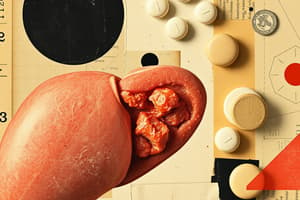Podcast
Questions and Answers
What does pharmacodynamics primarily study?
What does pharmacodynamics primarily study?
- Drug removal from the body
- Drug absorption in the bloodstream
- Drug effects and mechanisms of action (correct)
- Drug safety and efficacy
What is the primary site for drug metabolism?
What is the primary site for drug metabolism?
- Liver (correct)
- Intestines
- Stomach
- Kidneys
Which type of adverse drug reaction is dose-dependent and predictable?
Which type of adverse drug reaction is dose-dependent and predictable?
- Type B
- Type C
- Type D
- Type A (correct)
Which route of administration does NOT directly enter the bloodstream?
Which route of administration does NOT directly enter the bloodstream?
What is the definition of the therapeutic index?
What is the definition of the therapeutic index?
What term refers to the prescribing of drugs for unapproved indications?
What term refers to the prescribing of drugs for unapproved indications?
Which interaction type involves drugs affecting each other's absorption, distribution, metabolism, or excretion?
Which interaction type involves drugs affecting each other's absorption, distribution, metabolism, or excretion?
Which phase is NOT part of the clinical trial process for drug approval?
Which phase is NOT part of the clinical trial process for drug approval?
Flashcards are hidden until you start studying
Study Notes
Overview of Pharmacology
- Definition: Study of drugs, their effects on biological systems, and their medical uses.
- Branches:
- Pharmacodynamics: Study of drug effects and mechanisms of action.
- Pharmacokinetics: Study of drug absorption, distribution, metabolism, and excretion (ADME).
Key Concepts
-
Drug Classification:
- By source: Natural, synthetic, semi-synthetic.
- By therapeutic use: Analgesics, antibiotics, antihypertensives, etc.
- By mechanism of action: Agonists, antagonists, enzymes inhibitors, etc.
-
Drug Action Mechanisms:
- Receptors: Proteins that drugs bind to initiate a response.
- Enzymes: Biological catalysts that drugs can inhibit or activate.
- Transporters: Proteins that facilitate drug movement across cell membranes.
-
Pharmacokinetics:
- Absorption: Process of drug entering the bloodstream.
- Distribution: Movement of the drug throughout the body's tissues.
- Metabolism: Transformation of the drug into active or inactive forms, primarily in the liver.
- Excretion: Removal of the drug from the body, mainly via kidneys.
-
Dosage and Administration:
- Routes of Administration: Oral, intravenous, intramuscular, subcutaneous, topical, etc.
- Dosage Forms: Tablets, capsules, injections, ointments, etc.
- Therapeutic Index: Measure of drug safety; ratio of toxic dose to therapeutic dose.
-
Adverse Drug Reactions (ADRs):
- Types of ADRs:
- Type A (Augmented): Predictable, dose-dependent.
- Type B (Bizarre): Unpredictable, not dose-dependent, often related to individual patient factors (allergies).
- Types of ADRs:
-
Drug Interactions:
- Pharmacodynamic Interactions: Drugs with similar or opposing effects.
- Pharmacokinetic Interactions: One drug affecting the ADME of another.
-
Regulatory Aspects:
- Drug Approval Process: Preclinical studies, clinical trials (Phases I-IV), FDA approval.
- Post-Marketing Surveillance: Monitoring drug safety and effectiveness after release.
-
Ethical Considerations:
- Informed Consent: Ensuring patients are fully aware of treatment options and risks.
- Off-Label Use: Prescribing drugs for unapproved indications.
Conclusion
- Pharmacology is a vital field that impacts drug development, therapeutic use, and patient safety. Understanding its principles is essential for effective medical practice.
Overview of Pharmacology
- Pharmacology is the study of drugs, their effects on biological systems, and their medical applications.
- The field is divided into two main branches:
- Pharmacodynamics: Explores drug effects and mechanisms of action on the body.
- Pharmacokinetics: Investigates the processes of drug absorption, distribution, metabolism, and excretion (ADME).
Key Concepts
-
Drug Classification:
- Classified by source:
- Natural (derived from plants/animals).
- Synthetic (man-made).
- Semi-synthetic (chemically modified natural products).
- Classified by therapeutic use:
- Includes analgesics (pain relief), antibiotics (infection treatment), and antihypertensives (blood pressure control).
- Classified by mechanism of action:
- Includes agonists (activate receptors) and antagonists (block receptor activity).
- Classified by source:
-
Drug Action Mechanisms:
- Receptors: Proteins that bind drugs to trigger physiological responses.
- Enzymes: Can be inhibited or activated by drugs, influencing biochemical reactions.
- Transporters: Facilitate the movement of drugs across cell membranes.
-
Pharmacokinetics:
- Absorption: Refers to how drugs enter the bloodstream.
- Distribution: Involves the dispersion of drugs throughout body tissues.
- Metabolism: Primarily occurs in the liver, transforming drugs into active or inactive forms.
- Excretion: The removal of drugs from the body, mainly performed by the kidneys.
-
Dosage and Administration:
- Routes of Administration: Includes methods like oral, intravenous, intramuscular, subcutaneous, and topical.
- Dosage Forms: Common forms include tablets, capsules, injections, and ointments.
- Therapeutic Index: A ratio that indicates drug safety; compares the toxic dose to the therapeutic dose.
-
Adverse Drug Reactions (ADRs):
- Type A (Augmented): Predictable effects that are dose-dependent.
- Type B (Bizarre): Unpredictable and not dose-dependent; often linked to individual patient factors such as allergies.
-
Drug Interactions:
- Pharmacodynamic Interactions: Occur when drugs have similar or opposing effects.
- Pharmacokinetic Interactions: Happen when one drug modifies the absorption, distribution, metabolism, or excretion of another.
-
Regulatory Aspects:
- Drug Approval Process: Involves preclinical studies, human clinical trials (Phases I-IV), and final approval by the FDA.
- Post-Marketing Surveillance: Ongoing monitoring of drug safety and efficacy post-approval.
-
Ethical Considerations:
- Informed Consent: The necessity for patients to understand treatment options and associated risks.
- Off-Label Use: Refers to prescribing medications for uses not officially approved.
Conclusion
- Pharmacology is crucial for drug development, therapeutic application, and ensuring patient safety. Knowledge of its principles is essential for effective medical practice.
Studying That Suits You
Use AI to generate personalized quizzes and flashcards to suit your learning preferences.





